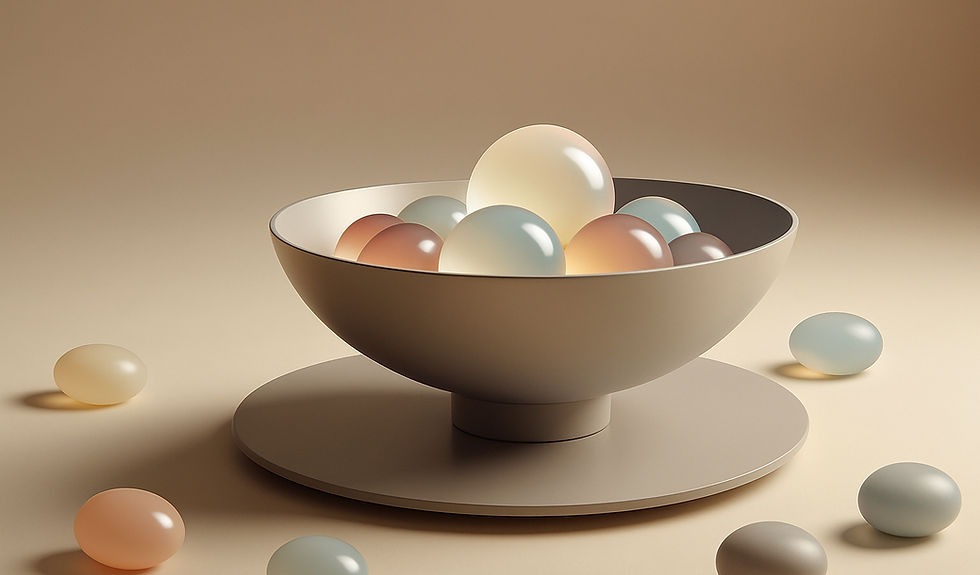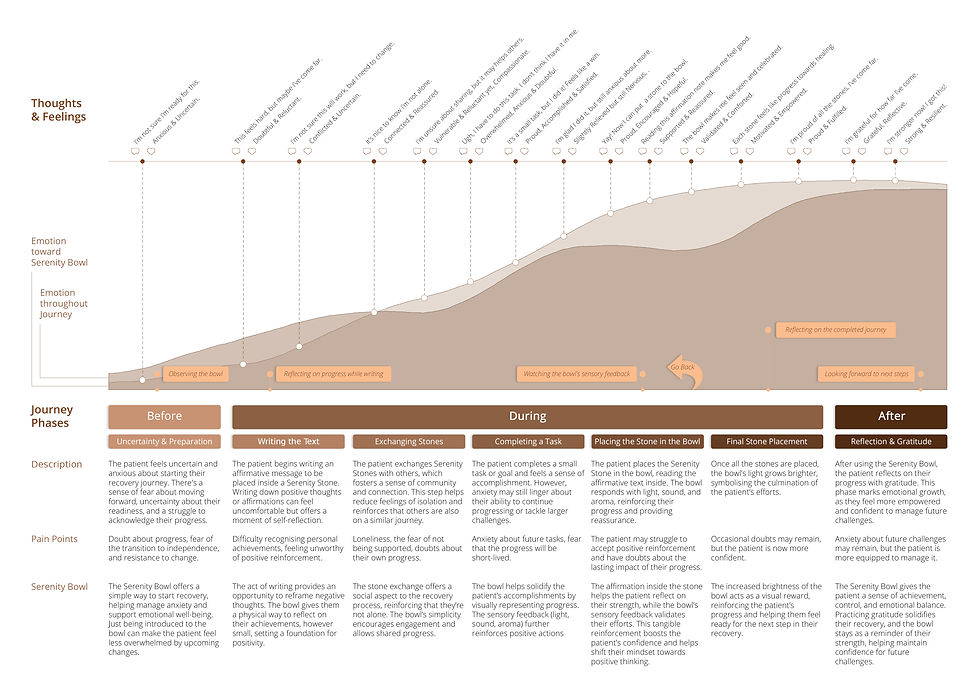
Serenity Bowl
November 2024 - February 2025
Group Project · Master Level · Industrial Design Engineering
Course: Multisensory Design
This course focused on designing for all sensory modalities—beyond just the visual. It explored how users perceive and experience products through sight, sound, touch, and other senses, and how these modalities interact to shape overall product experience. Through expert interviews and a final design project, theory was applied in practice by translating a desired experience into a multimodal design, with a strong focus on user perception and meaningful interaction.
This project, developed in collaboration with Erasmus MC, explores the design of a multisensory product to support patients recovering from severe depression during their transition from psychiatric care to independent living. Centred on a deep understanding of patient needs and therapeutic practices, the final design—The Serenity Bowl—aims to encourage progress recognition, emotional regulation, and habit formation through light, sound, scent, and tactile interaction. Through a human-centred and research-informed approach, the product integrates conceptual metaphors and feedback mechanisms to reinforce user confidence.
It is worth noting that this project has been accepted for presentation in the Dutch Design Week 2025 journal.
Design Principles
From expert interviews, patient personas, and therapeutic literature reviewed during the early stages of the project, core principles were distilled. By identifying recurring emotional needs, such as the desire for autonomy, moments of reflection, and sensory grounding, the team translated these insights into actionable principles. Three core principles guided the design development:
-
Habit Building: Encouraging consistent interaction to support routine and long-term stability.
-
Feedback Mechanisms: Providing clear and calming sensory responses to reinforce small achievements.
-
Conceptual Metaphors: Translating abstract experiences like emotional growth into tangible, meaningful interactions.
Challenge Definition
To understand the emotional and behavioural landscape of patients recovering from severe depression, the project began with expert interviews, including a practising therapist from Erasmus MC. These insights revealed key issues such as difficulty recognising personal progress, emotional relapse during transitions, and an over-reliance on structured care. Based on this qualitative input, the team developed personas that embodied typical patient experiences and challenges. These personas reflected emotional states, daily routines, and psychological triggers, serving as empathetic anchors throughout the design process and ensuring that decisions were tailored to the real needs of users.
Design Process
The process began with brainstorming methods such as Lotus Blossom and empathy mapping, generating a wide range of ideas from wearable sensors to ambient light installations. Among them, the concept of a tactile, sensory ‘fire bowl’ stood out. It evolved through iterative feedback loops, including fishbowl sessions and discussions with the therapist. Concerns about emotional triggers (e.g., fire symbolism) led to a shift toward an ocean-inspired theme—calm, deep, and healing. Each iteration focused on aligning the form, material, and interaction with the emotional state of the user.
Final Design
The final outcome, The Serenity Bowl, is an interactive object that uses light, scent, sound, and texture to support daily emotional grounding. Patients use translucent silicone stones to reflect on daily milestones—each placed stone activates calming stimuli such as ambient lighting (in soothing hues), gentle ocean sounds, and subtle scent diffusion. Motivational affirmations can be added to the stones, either pre-written or personalised, making the experience both reflective and uplifting. The design prioritises hygiene, safety, and ease of use, making it suitable for both hospital and home environments.
Patient Journey
The patient journey with the Serenity Bowl is designed to be gentle and intuitive, encouraging users to reflect on small moments of progress throughout their day. In the morning, patients may begin by selecting a motivational stone, setting a positive intention. As the day unfolds, they can place stones into the bowl to acknowledge personal achievements or emotional milestones, each interaction triggering a calming multisensory response. To ensure the design met patient needs and aligned with their daily routines, a journey map was developed using the established personas. This helped evaluate the bowl’s relevance and emotional impact across key moments in the recovery process.

Personal Contributions
Throughout this project, I took on a proactive and central role, managing both the team’s workflow and content direction. I chaired meetings, coordinated timelines, and ensured the project stayed on track. In the design process, I developed one of the core personas and independently created all the ideation sketches featured in the portfolio. I also made a major contribution to the concept development phase, actively shaping the design direction. The patient journey map was developed entirely by me, ensuring alignment with the needs of our personas. In addition, I independently produced all the digital sketches for the final concept and fully designed the visual material for the presentation poster.

















